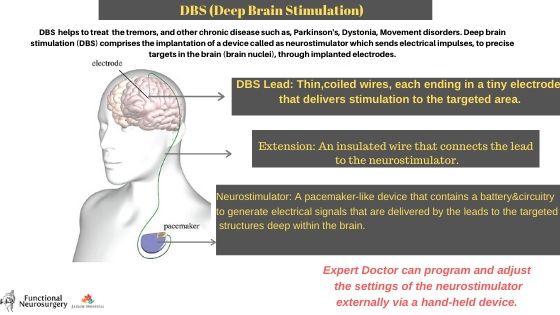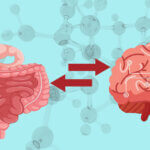All You Wanted to Know About Deep Brain Stimulation Surgery: Dr. Paresh Doshi
Deep brain stimulation surgery (DBS) is a neurosurgical procedure used to treat movement disorders like Parkinson’s disease, essential tremor, dystonia, and other neurological conditions. During DBS surgery, small electrodes called leads are implanted in specific areas of the brain. These leads receive electrical stimulation from a pulse generator implanted in the chest. The electrical currents from the pulse generator help regulate and interrupt the irregular brain signals that cause movement-related symptoms in neurological conditions. DBS can improve quality of life by reducing the need for medications and alleviating symptoms, though it may not completely eliminate the condition. Patients must undergo thorough evaluations before and after surgery, and the procedure requires precise electrode placement and adjustments to the pulse generator for successful outcomes.
The first modern DBS surgery procedure was conducted by Prof. Benabid in France, reported in 1995, and published in 1997. We began performing DBS in 1999, marking the first DBS procedure in India after receiving training from Prof. Benabid. Over 150,000 patients have now undergone DBS procedures worldwide.
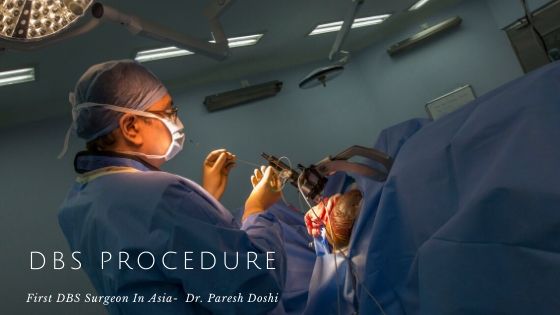
When is The Ideal Time To Undergo DBS Surgery Procedure?
In the initial years of disease, PD is controlled by medications. The patient hardly requires dbs surgery intervention to control the disease, the exception being, uncontrolled tremors which are seen in only 10 to 15% of the patients of Parkinson’s disease.
However, a few years down the line the disease progresses and the side effects of medicines are seen.
The most common side effects include motor fluctuations, In the form of sudden periods or unpredictable periods, hallucinations, dyskinesias or symptoms attributable to dopamine dysregulation.
At this time increasing the dose of medication is not helpful as it only brings in more side effects.
The patient usually start changing doctors in search of better control of the disease, however, every change that brings some improvement becomes increasingly short-lived.
Usually period comes 6 to 7 years after the disease progress is, however, it can occur earlier in some patients, especially if the patient got PD at a young age of less than 40. It has been in the opinion of all International experts in the field that the onset of motor fluctuations should initiate the discussions for surgery.
We believe that the deep brain stimulation surgery should be offered to the patient when his disease is not adequately controlled by medical management and his quality of life is getting impaired.
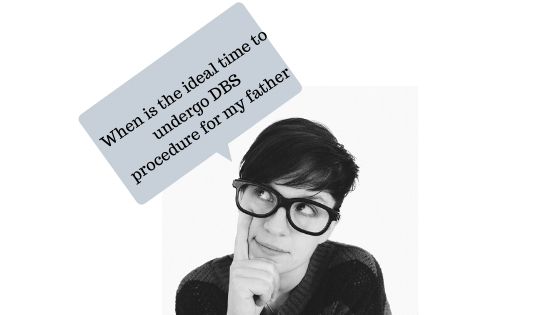
In 2013, a landmark study was performed across seven centers in Europe which concluded that offering surgery early in the course of the disease, after the motor fluctuations are set in, would not only improve the quality of life but also helped patients to reduce the medication dosage and avoid long term side effects.
One can Google this by the name of the EARLY STIM study for more information. Even the USA FDA has given approval for performing studies early in the disease.
What Are The Benefits of DBS Surgery?
Deep Brain Stimulation (DBS) surgery is a treatment option primarily used for managing symptoms of certain neurological conditions, such as Parkinson’s disease, essential tremor, dystonia, and obsessive-compulsive disorder (OCD). The benefits of DBS surgery include:
- Deep Brain Stimulation (DBS) works by delivering electrical impulses to targeted areas of the brain through implanted electrodes. These pulses modulate the abnormal neuronal activity responsible for motor symptoms in conditions like Parkinson’s disease. By effectively “resetting” or modulating brain circuitry, DBS helps alleviate symptoms and restore more normal brain function.
- Parkinson’s disease patients often experience motor fluctuations, where medication effectiveness wears off, leading to periods of decreased symptom control. DBS can help reduce these fluctuations, providing more consistent symptom management throughout the day and improving overall quality of life.
- Beyond symptom reduction, DBS can lead to improved motor control, coordination, and movement fluidity. This can translate to better mobility, reduced falls, and increased independence in daily activities for individuals living with conditions like Parkinson’s disease.
- Patients may experience an overall improvement in their quality of life, including the ability to engage in activities of daily living, such as eating, bathing, and feeding themselves more independently.
- Studies have shown that DBS can offer sustained symptom relief over the long term, with many patients experiencing improved quality of life for years after DBS surgery. This long-lasting efficacy underscores the value of DBS as a durable treatment option for certain neurological conditions.
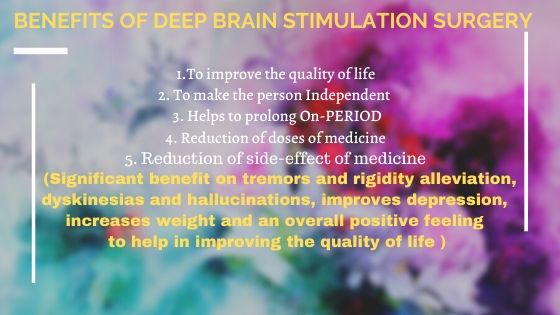
However, all the patients do not benefit equally and hence it is very important that your surgeon understands what he can deliver by surgery and what he can improve by medical management so that you can understand the exact outcome of the surgery.
Most of the centers do not have adequate experience to give you convincing and confident answers to all these questions which are very important to the patient.
Can you describe a typical Deep Brain Stimulation surgical procedure?
Deep Brain Stimulation (DBS) is a surgical procedure that involves delivering high-frequency electrical stimulation to specific areas of the brain. This is achieved by implanting a thin wire with electrodes at the tip into the brain. The electrodes are precisely placed into a brain site that carries the abnormal signals producing the symptoms.
The high-frequency stimulation alters these abnormal signals, leading to an improvement in symptoms. The location of electrode placement varies based on the illness being treated. Before the procedure, a pre-operative evaluation is performed to maximize the success of DBS surgery. This evaluation may include a brain MRI scan, neuropsychological testing, videotaped evaluation of movement both on and off medication, and other tests if indicated.
The precise placement of the electrodes is achieved through a combination of MRI measurement and intraoperative microelectrode mapping. Once the electrodes are placed, the wire is connected to the neurostimulator power supply, which is a battery-operated generator placed under the skin near the collarbone. This system, often referred to as a brain pacemaker, regulates the abnormal signals resulting from the disease process. The electrodes send electrical impulses that help normalize abnormal impulses. It does so without destroying healthy brain tissue.
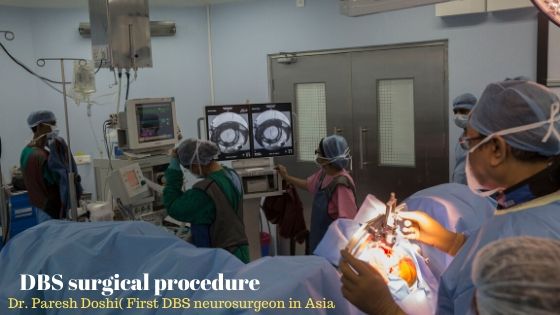
What would be the follow-up schedule after DBS surgery
Life after Deep Brain Stimulation (DBS) surgery varies for each individual, but it often brings hope for improved symptom management and quality of life. Successful DBS can lead to symptom improvements and potential reductions in medication reliance, while close collaboration with healthcare providers is crucial for fine-tuning treatment. Engaging in rehabilitation, maintaining a support network, and prioritizing a healthy lifestyle are important considerations. Emotional and psychological adjustments may be part of the post-surgery experience, and regular follow-up care helps monitor progress and make necessary adjustments. Ultimately, life after DBS surgery can offer renewed hope and opportunities for individuals managing neurological conditions.
As we have a large experience of operating patients of Parkinson’s disease we are very confident that our initial programming will give the desired benefit to around 70% of the patient. However, there are some patients who may need reprogramming in the first three months after surgery once the initial effect of surgery wears off.
We always recommend to the patient that they should be repaired to come back to our center once in the first three months if required. We do not charge for any reprogramming for the first time and this is covered in the cost of deep brain stimulation surgery (except if the patient gets admitted).
One’s the patient has reached stable programming parameters we give them two or three different programs so that they can adjust to the requirement after they go back to the routine.
What are the different types of pacemakers of DBS and what are their merits and demerits?
Presently there are two companies in the country that have the infrastructure and direct presence to offer DBS solutions.
There are other companies that work through the distributors, which we do not endorse, as we do not know when they will stop the services and the patient may be left with the pacemakers which cannot be serviced.
The first is the Medtronic company which offers two types of pacemakers one is non-rechargeable and the other is rechargeable.
These pacemakers are MRI compatible, so one can undergo MRI with certain restrictions. There are specific advantages and disadvantages of rechargeable and non-rechargeable pacemaker which is best explained personally when we meet.

The second company is Boston scientific that offers rechargeable pacemakers who have the duration of life for 25 years.
However, these pacemakers are not MRI compatible and hence if a patient needs to undergo MRI then he will have to find another alternative form of investigation.
Once again there are several subtle advantages and disadvantages of both these systems, that can be discussed personally.
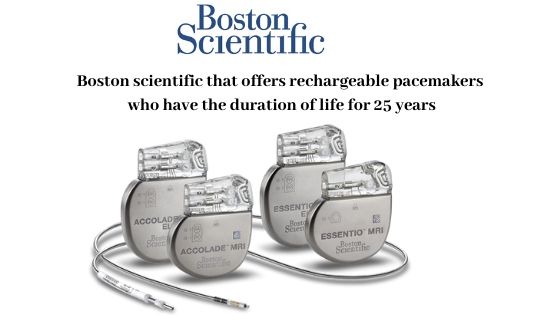
What precautions will be needed after DBS?
After surgery, we will provide you with a detailed list of dos and don’ts that you have to take care of in order to safeguard the pacemaker. Broadly speaking, you can continue to do all the normal activities that you would like to do, e.g. swimming, dancing, jogging or any kind of exercise, use of cell phone, microwave oven, driving, etc.
What are the risks of DBS surgery?
Deep Brain Stimulation (DBS) surgery, while offering significant benefits for individuals with certain neurological conditions, also carries some risks and potential complications. Here are some potential risks and complications associated with DBS:
- Surgical Risks: The DBS surgery itself carries risks similar to other brain surgeries, such as bleeding, infection, and adverse reactions to anesthesia. These risks are generally low but exist as with any invasive procedure.
- Device-related Complications: After implantation, the DBS device may be associated with certain complications, including infection at the implant site, lead migration (shifting of the electrode from its intended placement), or hardware-related issues, such as device malfunction or breakage. These can necessitate additional surgical procedures to address.
- Cognitive and Behavioral Changes: In some cases, individuals undergoing DBS may experience cognitive or behavioral changes, such as changes in mood, personality, or cognitive function. These changes are usually mild and reversible, but in some cases, they can be more pronounced and require adjustments to the stimulation settings.
- Speech and Swallowing Difficulties: Placement of the electrodes can lead to temporary or persistent speech and swallowing difficulties in some patients, particularly if the targeted brain areas are close to structures involved in these functions.
- Seizures: DBS has been associated with an increased risk of seizures, particularly in patients with a history of epilepsy or other seizure disorders. Careful monitoring and adjustment of stimulation settings can help mitigate this risk.
Why is the surgery done in two stages?
We perform surgery in two stages because we feel that this increases the safety of the procedure.
The first surgery is done the local anesthesia, after which the patient can be returned back to the room and given levodopa and meal, so as not to keep him off medications for too long.
The next day we can do the surgery under general anesthesia which is safe for the patient.
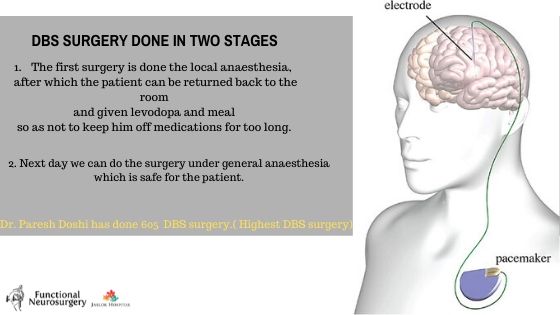
The two-stage approach serves several purposes:
- It allows for detailed pre-operative planning and imaging to precisely target the optimal brain region for electrode placement.
- Performing the lead implantation with the patient awake enables real-time feedback and testing to confirm the correct positioning of the electrodes.
- Splitting the procedure into two stages reduces the overall surgical time and risk compared to trying to complete the entire DBS implantation in a single operation.
This staged approach is considered the standard of care for DBS surgery, as it helps maximize the chances of accurate electrode placement and minimize potential complications. We will discuss this more in detail when we meet. We are aware that this increases the cost of the surgery but we do not want to reduce the cost and compromise on Patient Safety.
Is the DBS surgery painful, as it is done under local anaesthesia?
There is an initial pain of a minimal pinprick when we give u local anesthesia, however, once the local anesthesia text effect you will not feel any pain during the surgery.
However, you would realize that we are working on your head and we will be keeping you informed of all the things that we would be doing during the procedure as we go along the procedure.
This increases the patient comfort and confidence in the procedure and none of our patients has ever felt that he had a traumatic experience from the surgery.
I am an elderly patient and I have heard that the surgery is risky or not advisable?
Usually, people are reluctant to offer surgery to elderly patient for several reasons.
One of them being scepticism about getting a good outcome.
However, long-standing experience and the opportunity to probably operate on the largest number of elderly patients in the world has helped us to tailor the treatment to make the surgery safe and effective for elderly patients.
For example, we use different targets if the patient has got some amount of cognitive or memory impairment.
If the patient cannot tolerate surgery under local anaesthesia we can do it with conscious sedation.
We also prepare ourselves, patient and the relatives to ensure that the surgical experience remains as comfortable as one would wish it to be.
We recently published our outcome of elderly patients versus young patient operated at our centre and found that there was no increased rate of complication and the improvement in Parkinson’s disease was more or less similar ‘(fig young vs old)
Will I be required to follow up with my Neurologist? Who adjusts the medical treatment after surgery?
If you are in touch with the movement disorder specialist then we may be able to speak to him and explain to him the parameters that we have set and what we expect in terms of medication changes.
However, if you feel that you are more comfortable with us making both the changes i.e. stimulation parameters and medications we would be happy and confident to do the same.
What is programming and how important is it in the outcome of DBS surgery?
Programming is The Key to the success of DBS.
Even if you have got the surgery done pretty well, if you cannot program the pacemaker correctly, it is like having the best computer at your disposal but not having the skills to use it.
If I have to give an example, Microsoft Excel is a program used by everyone, but the way an analyst/accountant can use that is far different from me using it.
Hence, to extract the full benefit of surgery, correct knowledge to program the pacemaker is very critical.
Our team has 1000s of hours of programming experience and hence we can immediately assess the response of each program subset and offer the best.
In fact, we have been able to capture the benefit of surgery for the patients who have been operated in other centers, just by fine-tuning the pacemaker, which that particular center could not do. (read testimonial)
What do our patients say
Finally, what are the differentiating points in your center?
- DBS is not a procedure for us but it is a religion we practice it with great faith and passion to ensure that the patients were putting trust in the US are awarded to the best of our abilities.
- We have one of the experiences of performing DBS surgery by a single and Esteem over the last 20 years or more than 500 patients.
- The engagement with the center is not limited to the surgical procedure, like this (surgical procedure) can be done by other people also, however, the postoperative management, understanding the Symptoms and Signs of advancing PD, understanding the limitations that you can treat and not treat and having the ability to use all the skills that are needed to program these patients, to achieve benefit out of DBS is the USP of our center, which no other Centre can replicate.
- Apart from offering the best care and support to the patient, we have worked very hard to minimize the risk and complications of surgery and we are confident today to offer this surgery to patients who are usually considered not amenable to surgical treatment e.g. patients above 80 years
- We are the only center in the country that has extensively published our work in Peer-reviewed journals to give credibility to our program.
- There have been several research projects, like comparing the infection rate amongst different categories of room accommodation at our hospital, which method of targeting is foolproof, can we use a resterilized pacemaker, etc. conducted at our hospital in the last 20 years to improve the patient outcome.

